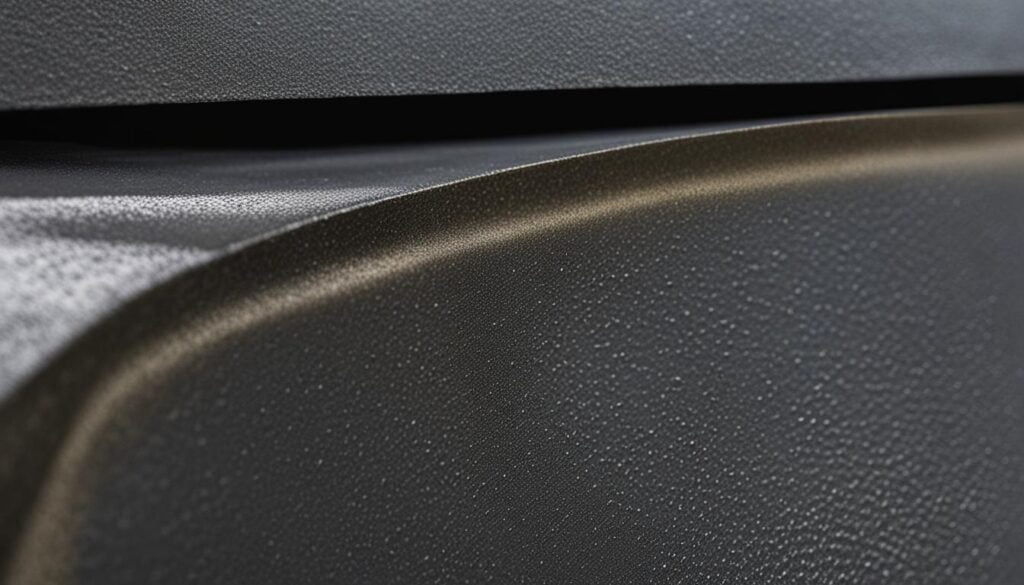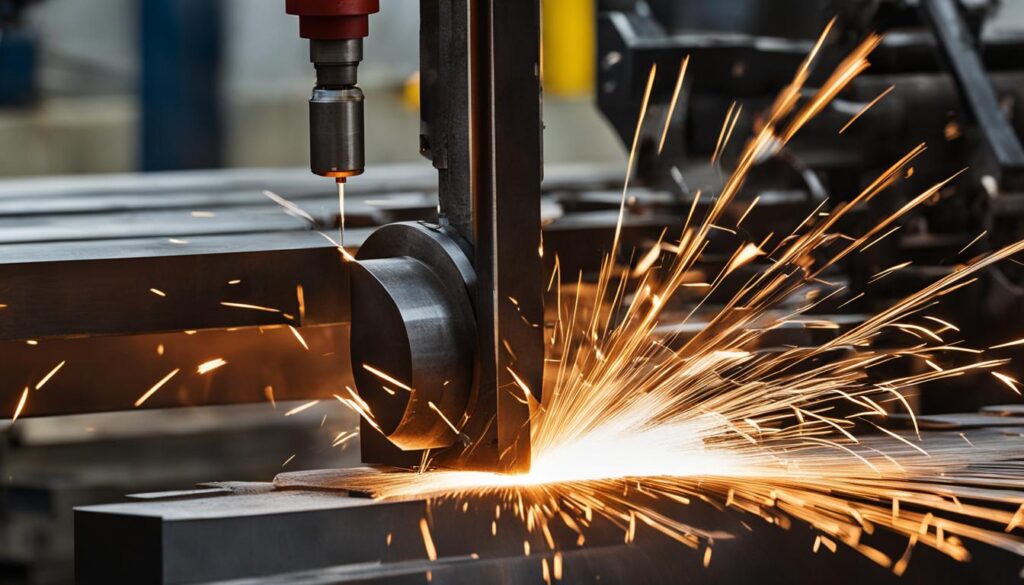In the world of industrial efficiency and material engineering, improving the durability of essential components is crucial to achieving excellence. Among the various materials available, alloy steel castings have made a name for themselves in being highly wear-resistant—a property that benefits numerous industries and applications. Through examining the role of surface hardness, we can discover how these alloys withstand wear, ensuring consistent performance and mitigating the potential for material deformation.
As we delve deeper into the design of wear-resistance alloy steel, you will gain a better understanding of the processes and treatments employed to create some of the most resilient materials available today. We will explore the elements of alloy steel durability while shedding light on the specific properties that contribute to resisting wear in these advanced metal mixes.
Key Takeaways
- Wear resistance is a crucial property in alloy steel castings for enhancing industrial efficiency
- Surface hardness plays a significant role in ensuring the durability of alloy steels and preventing material deformation
- Alloy steels utilize a variety of treatments and processes to enhance their wear resistance capabilities
- The composition of alloy steels contributes to their overall wear resistant properties in various applications
- Understanding wear resistance mechanics is vital for selecting the right materials in industrial and manufacturing endeavors
Exploring the Role of Surface Treatments in Enhancing Alloy Steel Durability

Surface treatments play a crucial role in improving the overall durability and performance of alloy steel components. In this section, we delve into various surface treatment techniques, including the hardening process, nitriding, and coating applications, to enhance the wear resistance and longevity of 4140 steel.
The Hardening Process and Its Impact on 4140 Steel
The hardening process significantly alters 4140 steel’s wear resistance by heating it to high temperatures and subsequently cooling it rapidly, enhancing both hardness and strength. This thermal treatment not only fortifies the steel but also makes it more resistant to wear, elevating its performance and longevity in diverse industrial applications. The increase in surface hardness positively affects 4140 steel durability, making it a favorable choice for industries that require a high-performance material.
Nitriding Techniques for Improved Wear Resistance
Nitriding is a surface treatment method that introduces a nitrogen-rich environment at elevated temperatures, promoting nitrogen atom diffusion into the steel’s surface. This diffusion creates a hardened surface layer on the 4140 steel, markedly improving both wear resistance and reducing friction between surfaces in contact. Nitriding treatment results in:
- Surface layer enhancement
- Increased surface hardness
- 4140 steel wear resistance
- Reduced friction
This nitrogen atmosphere simultaneously provides a unique balance of corrosion resistance and overall alloy steel performance, making nitriding an essential process for 4140 steel.
Coating Applications to Boost Alloy Steel Performance
Coatings like chromium or nickel can be applied to 4140 steel to provide resistance against corrosion as well as improve wear resistance. The application of ceramic coatings is another vital innovation that enhances the hardness of the steel, further barriers against wear, and reduces friction, which is pivotal in extending the service life of alloy steel components. The variety of coating options available to improve alloy steel performance include:
| Coating Type | Benefits |
|---|---|
| Chromium Coatings | Corrosion resistance, wear resistance, and low friction |
| Nickel Coatings | Corrosion resistance, wear resistance, and superior surface finish |
| Ceramic Coatings | Increased surface hardness, wear resistance, and thermal barrier |
Ultimately, the choice of coating depends on the desired properties and performance required from the alloy steel component, as well as the specific industrial environment and application.
Delving into 1.2085 Steel: Composition and Industrial Applications

1.2085 steel, also known as X33CrS16, is a unique martensitic stainless steel renowned for its high wear resistance and corrosion resistance. Comprised of carbon, chromium, sulfur, and silicon, it offers outstanding mechanical properties that make it a material of choice for numerous critical applications across various industries.
Some of the primary industrial applications of 1.2085 steel include:
- Injection molds
- Cutting tools
- Medical instruments
- Automotive industry components
The key features of 1.2085 steel that make it suitable for these applications are its high hardness, impressive corrosion resistance, and its ability to withstand extreme temperatures up to 300°C (572°F). This combination of properties ensures both precision in manufacturing and durability in use, making 1.2085 steel a popular choice for numerous industrial applications.
1.2085 steel: a high-performance martensitic stainless steel with exceptional wear and corrosion resistance for numerous industrial applications.
One significant advantage of 1.2085 steel is its martensitic stainless steel composition, which provides improved wear resistance compared to other stainless steel types. Martensitic stainless steels are characterized by a higher carbon content than other stainless steels, resulting in a higher hardness, which ultimately translates to increased wear resistance.
| Property | 1.2085 Steel | Other Stainless Steels |
|---|---|---|
| Wear Resistance | High | Low to moderate |
| Corrosion Resistance | High | High |
| Hardness | High | Low to high (depending on the type) |
| Temperature Resistance | Up to 300°C (572°F) | Variable (depending on the type) |
As industries continue to evolve, there is a growing demand for materials that can withstand harsh conditions while maintaining their properties. With its exceptional wear resistance, corrosion resistance, and ability to handle extreme temperatures, 1.2085 steel fits the bill, making it an indispensable material for various essential applications.
Conclusion: KT-Foundry’s Commitment to Advanced Wear-Resistant Solutions
Advancements in wear resistance technology play a crucial role in maintaining the durability and efficiency of machinery and tools within various industries. Continuous research has been pivotal for refining and enhancing the properties of materials like H13 steel, which includes a complex composition of chromium, carbon, vanadium, molybdenum, and silicon, each contributing uniquely to the alloy’s property of resistance against heat, mechanical stress, and wear.
The Future of Wear Resistance Technology in Industry
Our dedication at KT-Foundry extends to delivering superior alloy steel castings adhering to rigorous standards of quality and incorporating the latest innovations in wear resistance. The emphasis lies on procuring materials like H13 steel with optimal chromium-carbide bonds and a balance of strength and toughness, ensuring our products withstand extreme conditions and stresses. Alloy steel’s unique constituent interplay guarantees high-performance in challenging environments, mirroring our commitment to excellence and leading-edge solutions.
Our Dedication to Quality and Innovation in Alloy Steel Castings
At KT-Foundry, we prioritize quality commitment and embrace innovative industrial applications through continuous improvements in our casting processes and implementation of future innovations in wear resistance technology. Our focus on industrial advancements and material science ensures that our customers receive quality alloy steel castings that meet their unique needs and contribute to KT-Foundry excellence.
FAQ
What is the significance of wear resistance in alloy steel castings?
Wear resistance in alloy steel castings is crucial for preventing surface damage, material loss, and deformation. By increasing surface hardness and reducing friction, wear resistance ensures industrial efficiency and improved alloy durability in various applications.
How does the hardening process impact 4140 steel’s wear resistance?
The hardening process involves heating 4140 steel to high temperatures and cooling it rapidly. This treatment enhances the steel’s hardness, strength, wear resistance, and overall performance in diverse industrial applications.
What role does nitriding play in improving wear resistance?
Nitriding is a technique that introduces a nitrogen-rich environment at elevated temperatures, promoting nitrogen atom diffusion into the steel’s surface. The process forms a hardened surface layer on 4140 steel, significantly improving wear resistance and reducing friction between contacting surfaces.
How can coatings enhance alloy steel performance and wear resistance?
Coatings such as chromium, nickel, or ceramic can be applied to alloy steel, like 4140 steel, to provide corrosion resistance and boost wear resistance. These coatings increase the hardness of the steel and reduce friction, extending the service life of alloy steel components in various industries.
What is the composition and significance of 1.2085 steel in industrial applications?
1.2085 steel, or X33CrS16, is a martensitic stainless steel composed of carbon, chromium, sulfur, and silicon. Its high wear resistance, hardness, corrosion resistance, and ability to withstand extreme temperatures make it a material of choice in industries such as injection molding, cutting tools, medical instrument manufacturing, and automotive applications.
How does KT-Foundry commit to providing advanced wear-resistant solutions in their alloy steel castings?
KT-Foundry is dedicated to delivering superior alloy steel castings compliant with rigorous quality standards and incorporating the latest wear resistance innovations. They use materials like H13 steel with optimal chromium-carbide bonds and a balance of strength and toughness, ensuring their products stand up to extreme conditions and stresses while providing high-performance in challenging environments.


